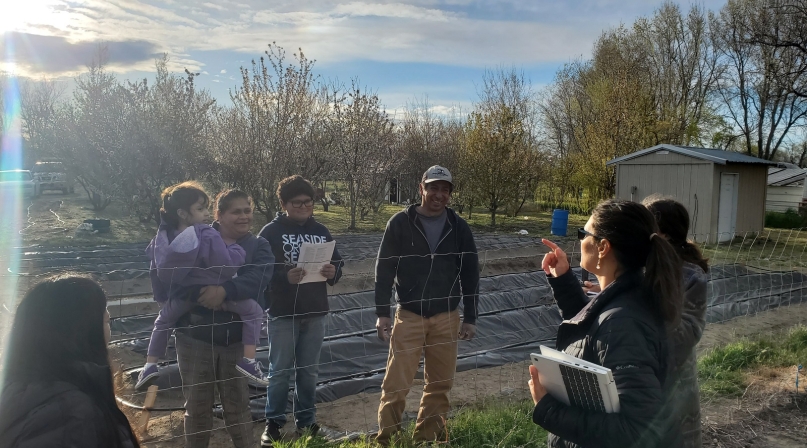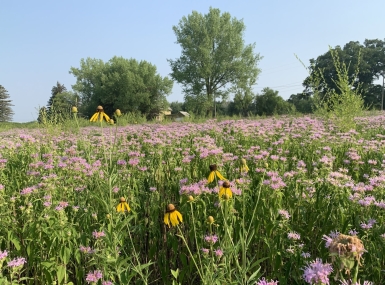Nitrates in water raise alarm for Oregon county

Key Takeaways
The hardest thing Ana Pineyro felt was the sense of resignation. As she and Commissioner Jim Doherty went door-to-door in Morrow County, Ore. informing households about dangerous nitrate levels, she learned that some residents knew there was a problem with their drinking water, and either couldn’t or wouldn’t do anything about it.
Couldn’t, because the cost of buying water could run between $80-$300 a month. Wouldn’t, because what was the difference?
“They have been dealing with this issue for so long that they are used to it, they no longer find themselves entitled to request clean water,” she said. “They essentially say, ‘We deal with what we have.’”
Maybe they had come from Central American countries where the daily risks inherent in their lives were so prevalent that they feel fortunate just to have safety from immediate bodily harm. Morrow County is on the verge of being the first minority-majority county in Oregon, an agricultural center with the state’s busiest port. There, processing of crops leaves the wastewater full of nitrogen, and the port pumps water laced with nitrogen to farm fields, where it can convert into nitrate and seep into the aquifer beneath Morrow and Umatilla counties.
Some of the Morrow County residents who rely on wells for drinking water said they knew about the nitrate problem but confidently boiled their water beforehand, which was fruitless in reducing the dangerous health effects from drinking it: elevated risks of cancer or miscarriage.
Drinking water that has high levels of nitrate can cause other health effects, according to the Oregon Health Authority, such as:
• Methemoglobinemia or “blue baby syndrome,” which results from nitrate decreasing the blood’s capacity to carry oxygen, especially in infants who receive baby formula mixed with water containing nitrate above 10 mg/L.
• Potential increased risk of: Recurrent respiratory infections; thyroid dysfunction; negative reproductive outcomes such as spontaneous abortion and certain cancers including cancer of the stomach or bladder.
It became crucial to let residents know how to keep themselves safe and make their needs apparent.
“I’m beginning to understand what environmental justice is,” Doherty said. “These folks don’t have a voice, and if you’re going do something to the air they breathe or the water they drink, you have to give them a voice.”
Pineyro has been giving them that voice in her role in Morrow County’s public health department. She’s a communicable disease coordinator and her native Spanish has been crucial to reaching non-English speaking residents who make up most of the population at risk.
“I was trying to visit with these folks who didn’t speak my language and I thought ‘this is just not working,’ plus I don’t know the health implications,” Doherty said. “Ana put together a protocol of questions about drinking the water, all the information in English and Spanish, and she’s been the one making the difference.”
It’s a stunning change in perspective for Doherty, who was dismayed when he saw test after test come back showing dangerous water.
“You grow up thinking that you can turn on the taps and water is always going to be there, it’s always going to be fresh and pure,” he said. “We recognize that that’s not the case.”
Now, Morrow County and the Association of Oregon Counties are not only looking after the issue with a galvanized focus, but they are trying to raise awareness in agricultural counties across the nation. The Morrow County Commission declared a local state of emergency, which gives commissioners the authority to establish procedures to prevent, minimize and respond to the water pollution issue and to coordinate with state and federal agencies for emergency financial assistance. That can include include funding for reimbursement for dozens of tests the county bought to use on people’s tap water, and money to pay for reverse osmosis filters for people with tainted wells.
“This is a public health crisis — this is our Flint, Michigan,” said Gina Nikkel, executive director of the Association of Oregon Counties. “When it appears in such a small rural Oregon county, you wonder ‘How many other counties are in the same situation?’ particularly in states where agriculture is as important as it is in Oregon. If you think what happened in Flint can’t happen where you live, you’re wrong.”
The state Department of Environmental Quality fined the Port of Morrow $1.3 million in January 2022, but the consequences of that sustained contamination may cost more than that to fix. Morrow County and the state association have put their hopes in the U.S. Department of Agriculture’s Rural Development state office while awaiting response from the Environmental Protection Agency, while also applying for a Rural Community Assistance Partnership grant to help pay for water delivery and filter installation.
Doherty had planned to make nitrate contamination a priority when he took office in 2017, but it fell by the wayside until recent testing of deep wells showed almost universal contamination. He has used those regrets of not starting work earlier as his driving force in addressing the problem.
It wasn’t the first time he saw government react slowly, and it wasn’t the last. A recent Oregon Capital Chronicle investigation showed the state Department of Environmental Quality was soft on the Port of Morrow’s industrial pollution for years, never revoking the port’s wastewater permit or mandating reduced nitrogen levels in wastewater.
“In the ‘90s we started noticing the nitrates were starting to rise in some of the wells and so it’s a bit of a concern,” Doherty said. “The county put a citizen committee together, and it was, I always thought, that those folks at the state in charge were looking after these things.”
Morrow County has allocated $1 million for water delivery services and is in the process of finding a contractor.
“…we know everybody together kind of created this challenge a little,” Doherty said. “It’s a little discouraging that the port industrial park willfully violated their permit 1,164 times.
“It’s going to be a daunting task. People have told me that that I’m tilting at windmills and that I’ll never clean that aquifer in my lifetime. I said, ‘That’s not a reason not to start.’”
Attachments
Related News

U.S. Department of Energy announces $18 million for Local Government Energy Program
U.S. Department of Energy announces $18 million for Local Government Energy Program

Sherburne County and tribal nations collaborate on county park
Sherburne County, Minn. engaged tribal nations to revise its plans for a park that included a Native American burial ground.

U.S. Army Corps of Engineers publishes memo on protection of non-jurisdictional waters and wetlands
U.S. Army Corps of Engineers memo directs civil works actions on water and wetlands in response to recent Waters of the United States (WOTUS) changes.
